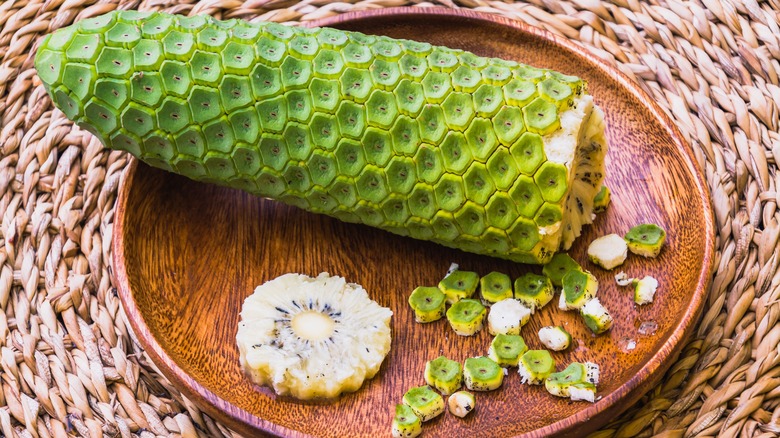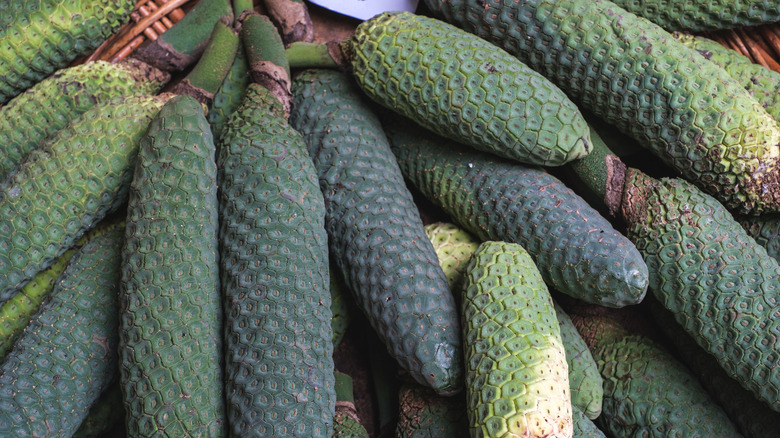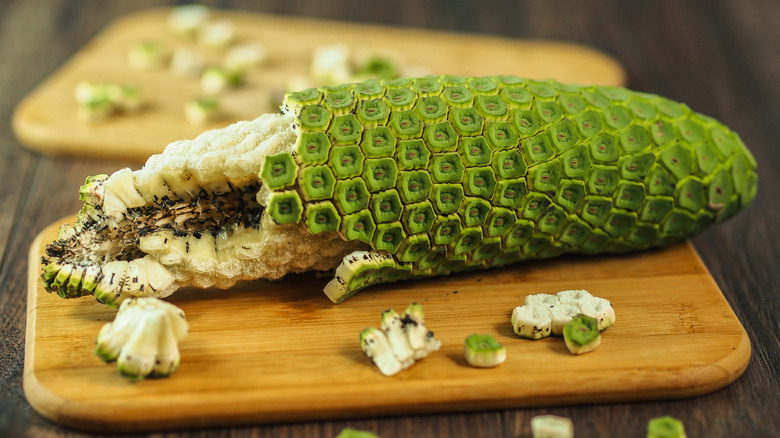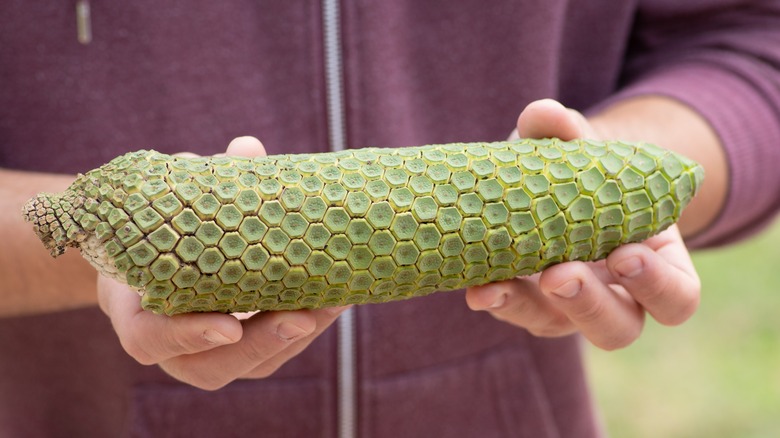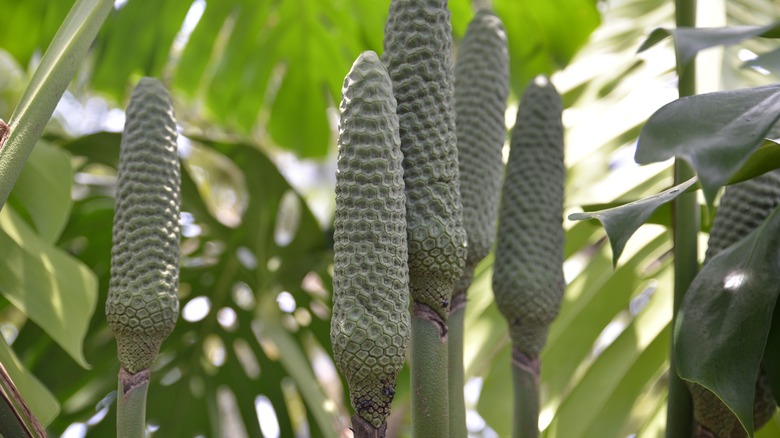Meet The Monstera Deliciosa, The Russian Roulette Of Fruit
Almost everything you need to know about the "Monstera deliciosa" fruit is contained in its name. Most people can decipher that it seems to sound a lot like "delicious monster" — and that's exactly what its scientific name translates to. "Monstera deliciosa" is also the name of the plant that bears the Monstera fruit, known by other names like Swiss cheese plant (due to the appearance of its large leaves dotted with holes), Mexican breadfruit plant, and fruit salad plant. These names all give a not-so-subtle hint at the flavor of the fruit that it grows.
Indeed, the Monstera fruit is a feast for the tastebuds, but if you eat it before it's fully ripened, you're in for some major discomfort. The Monstera resembles a long ear of corn covered in green scales. Beneath those scales lies its yellowish fruit, which also looks like kernels of corn. Timing is indeed everything when sampling this delightfully exotic fruit that thrives naturally in hot, humid conditions. Once its scales begin to come off on their own, and the fruit exudes its sweet and intoxicating aroma, it's ready to eat. Try to take a nibble too soon, however, and you'll wish you hadn't. You don't want to play that game of Russian roulette.
How is the Monstera fruit grown?
The "Monstera deliciosa" plant is native to Panama, Guatemala, southern Mexico, and Costa Rica, all of which have warm climates and high humidity. While the plant can certainly be grown in other locations, producing fruit requires ideal conditions. Some people grow the plants indoors purely as ornamental pieces. Though lush and unusual in appearance, indoor plants are unlikely to bear fruit because they need a lot of growing space to thrive. However, when cultivated and nurtured in a greenhouse, they are much more likely to produce fruit.
"Monstera deliciosa" can grow outdoors in the United States, but only in very limited locations, specifically in growing zones 10 through 12. These zones include the southernmost parts of Florida and California, as well as Hawaii and Puerto Rico. As these are among the warmest and most humid areas in the country, they provide the right environment for the plant. Healthy, mature Monstera plants in perfect conditions will blossom with white-colored flowers, leading to fruit development after about one year.
What does the Monstera taste like?
Monstera fruit has a very obvious way of signaling that it's ready to be eaten: Its green outer scales will begin to peel away on their own. When this happens, you should catch a delicious whiff of the ripe, creamy or yellow fruit underneath, which strongly resembles corn kernels. You can take the ripened fruit off with your fingers and eat it on its own.
The flavor of the Monstera's flesh is often described as a tropical blend of pineapple and banana, with some picking up notes of passion fruit and strawberry. TikTok user @Sooziethefoodie even described notes of raspberry and mango in a video — insights that contribute to the Monstera's reputation as a "fruit salad fruit."
In Mexico and Central American locations where the Monstera is plentiful, the fruit is often eaten fresh from the plant or preserved in jams. When cooking with the fruit at home, you can incorporate it into puddings, ice creams, fruit salads, cakes, smoothies, or tropical cocktails.
What happens if you eat the Monstera too early?
With many fruits, biting into them a little too early might result in sour or bitter flavors, or firm flesh that should be soft. These experiences are generally fairly harmless. However, diving into unripe "Monstera deliciosa" might leave you running from it for the rest of your life. The unripe fruit contains oxalic acid, which can irritate your skin and throat in an intensely uncomfortable way, and even create a literal burning sensation. As the fruit ripens, the calcium oxalate crystals within it dissipate, making the fruit safe to eat.
When the Monstera's outer scales begin peeling away on their own, it's ripe, so determining when to eat it isn't a guessing game. To hasten ripening, you can place the fruit in a glass and cover it with a paper bag until its scales begin peeling. Gently push the scales back with your finger; if they come off easily, the fruit is ready. If you have to use force, it's best to give the fruit more time.
Be aware that some believe a small amount of oxalic acid may remain in ripe fruit, so it's wise to eat it in moderation. While the fruit's flavor may tempt you to overdo it, keep in mind the fruit also acts as a laxative. You've been warned.
Nutritional information about Monstera fruit
If you can get your hands on Monstera fruit, it's an excellent way to add some variety to your diet, and boasts numerous beneficial nutritional properties. In a 100-gram serving (which is a little less than a quarter of a pound), "Monstera deliciosa" has just one gram of fat. In the same serving, there are 32 grams of carbohydrates, making the fruit a great choice if you're looking for an energy boost. A serving also contains 60 grams of the antioxidant vitamin C, excellent for battling free radicals and stress.
Additionally, a serving of Monstera contains 16 grams of bone-healthy calcium, and 23 grams of protein to help you feel fuller for longer. It's also a good source of potassium, aiding in maintaining healthy cellular fluid levels. Finally, the fruit has 10 grams of phosphorus, a key mineral for healthy teeth and bones. Together with B vitamins (also present in "Monstera deliciosa"), phosphorus aids in heart, kidney, muscle, and nerve health.

